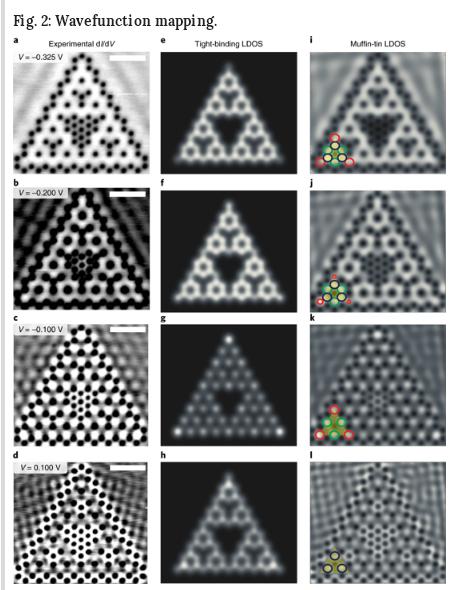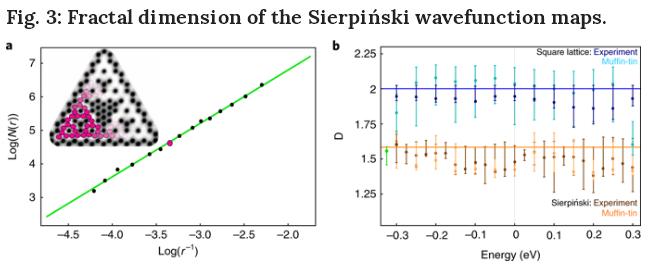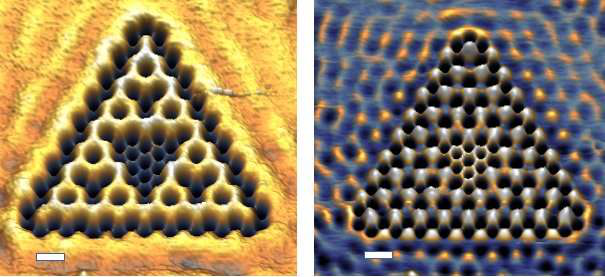博文
物理学家创建分形形状的电子
 精选
精选
|||
物理学家创建分形形状的电子
诸平


据荷兰乌特勒支大学(Utrecht University)和乌特勒支大学理学院(Utrecht University Faculty of Science)2018年11月12日提供的消息,乌特勒支大学理学院的研究人员2018年11月12日在《自然物理》(Nature Physics)杂志网站发表了他们的最新研究成果,建立了电子的分型状态。图1就是谢尔宾斯基三角形(Sierpiński triangles)的照片,右边的是电子处于非键(non-bonding)状态,而左边的图片则是电子处于成键(bonding)状态,基准尺度为2nm。

Fig. 1 Electrons in bonding (left) and non-bonding (right) Sierpiński triangles; scale bar 2nm. Credit: Kempkes et al., Nature Physics, 2018
众所周知,在物理学中电子在三维、二维和一维中的表现非常不同。这些行为会导致不同的技术和电子系统应用的可能性。但是如果电子处于在1.58维状态,究竟会发生什么呢?荷兰乌特勒支大学的理论物理学家和实验物理学家在调查这些问题,他们的一项新的研究结果已经在2018年11月12日发表于《自然物理》杂志网站——Sander N. Kempkes, Marlou R. Slot, Saoirsé E. Freeney, Stephan J.M. Zevenhuizen, Daniël Vanmaekelbergh, Ingmar Swart, Cristiane Morais Smith. Design and characterization of electrons in a fractal geometry. Nature Physics, 12 November 2018, DOI: 10.1038/s41567-018-0328-0.
对于处在1.58维的电子行为可能很难想象,其实并非如此,它要比你乍一看想象的更熟悉。非整数维,如1.58维,可以找到如肺一样的分形结构。一个分形自相似结构在尺度上与正常对象相比是不同的,如果你放大,你会看到同样的结构。例如,一小块罗马花椰菜(Romanesco broccoli)通常类似于整个的西兰花(broccoli)。在电子技术中,分形被用于天线就是利用了在很大的频率范围内的接收和发射信号的性质。
在分形学(fractals)中一种相对较新的话题就是量子行为,如果一直放大电子的所有尺度,量子行为就会浮现出来。使用量子模拟器,乌特勒支大学的物理学家Sander Kempkes和Marlou Slot能够建立这样一个分形的电子。研究人员制作了一个“松饼罐(muffin tin)”,将电子关在其中以便形成分形形状,通过将CO分子放置在配有扫描隧道显微镜的合适形状的铜背景上。被关在其中的电子结果形成三角形的分形形状,将这种分型形状被称为谢尔宾斯基三角形(Sierpiński triangles),分形维数为1.58维。研究人员观察到在此三角形中的电子实际上表现得好像他们处于1.58维的行为。
这项研究的结果显示如何将谢尔宾斯基三角按照能量分为成键(左图)和非键(右图)两种情况,通过这些分形结构产生很好的传输电流的机会。在成键的情况下,电子被连接起来,可以很容易地从一个地方到另一个地方(高传播),而在非成键情况下,电子未被连接在一起,需要“跳”到另一个地方(低传输)。同时,通过计算电子波函数的维度,研究人员观察电子本身局限于这个维度和波函数继承这个分数维度的相关情况。
理论物理学家Cristiane de Morais Smith和实验物理学家Ingmar Swart和Daniel Vanmaekelbergh一起监督和指导这项研究。理论物理学家Cristiane de Morais Smith说:“从理论的角度来看,这是一个非常有趣和突破性的结果。它打开一个全新的研究领域,提出了一些问题如:电子被局限在非整数维空间究竟实际上是意味着什么?它们表现得更像在一维还是在二维空间呢?如果打开一个垂直于样品的磁场会发生呢?分形已经有大量的应用,因此这些结果可能对于量子尺度产生巨大影响。”更多信息请注意浏览原文和相关报道。
Electrons in 1.58 dimensions? What the frac! (12 NOVEMBER 2018)
Quantum simulator' facilitates research into theoretical supermaterials�
Abstract
The dimensionality of an electronic quantum system is decisive for its properties. In one dimension, electrons form a Luttinger liquid, and in two dimensions, they exhibit the quantum Hall effect. However, very little is known about the behaviour of electrons in non-integer, or fractional dimensions1. Here, we show how arrays of artificial atoms can be defined by controlled positioning of CO molecules on a Cu (111) surface2,3,4, and how these sites couple to form electronic Sierpiński fractals. We characterize the electron wavefunctions at different energies with scanning tunnelling microscopy and spectroscopy, and show that they inherit the fractional dimension. Wavefunctions delocalized over the Sierpiński structure decompose into self-similar parts at higher energy, and this scale invariance can also be retrieved in reciprocal space. Our results show that electronic quantum fractals can be artificially created by atomic manipulation in a scanning tunnelling microscope. The same methodology will allow future studies to address fundamental questions about the effects of spin–orbit interactions and magnetic fields on electrons in non-integer dimensions. Moreover, the rational concept of artificial atoms can readily be transferred to planar semiconductor electronics, allowing for the exploration of electrons in a well-defined fractal geometry, including interactions and external fields.
https://blog.sciencenet.cn/blog-212210-1146109.html
上一篇:科学家在火星上捕捉到日出之声
下一篇:暗物质“飓风”来袭,检测轴子机遇难得
